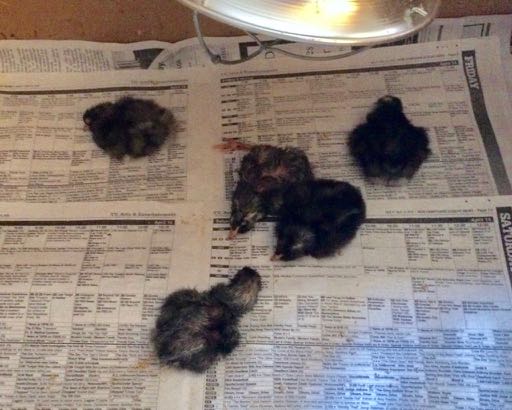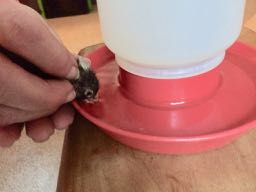
If they had been hatched by a broody hen, mama hen would have tended to all of their needs. If you incubate a clutch of eggs, YOU take on the role of mama. What should you do to ensure healthy, thriving chicks that grow into productive hens?
First off, leave them in the incubator for a few hours. The warm air and fan will help them dry their chick fluff feathers. Baby chicks are very vulnerable to heat loss. They can actually die of hypothermia at our room temperature. They need their chick fluff to keep in what little body heat they can muster.
When they’re a bit more fluffy, and assuming they’re healthy, you can move them to the brooder box. It’s hard not to smile at baby chicks, eh?
Having absorbed their egg’s yoke, a chick is actually okay for food for two or three days. During the first half day or so outside of the shell, they aren’t interested in food or water — just sleep. You don’t have to fret over making them eat on Day One. It’s okay if they eat on Day One, just not crucial. Their instinct to peck at tiny bits will kick in soon enough.
Central Heating
What IS crucial for a brooder box is a heat source. In nature, the mama hen would be their heat source. If you are the mama, you have to provide a heat source. The most common choice is a heat lamp — like a french fry lamp at the fast food joint.
Heat lamps work but have their drawbacks. For one, they tend to be too hot. 100 watts is plenty. Your goal is warming the chicks, not cooking them. If you use a heat lamp, be careful to check how hot things are down at chick level. Leave your hand on the bottom of the brooder box, palm down, exposing the more-tender back of your hand to the lamp, If your hand stings after 10 or 20 seconds, it’s too hot. Move the lamp higher.

A second drawback to heat lamps is that the chicks are exposed to light 24/7. Not having a day-night cycle adds stress. For the past several years, we’ve been using a ceramic emitter. (see photo above) These are usually sold for reptile pets. They emit a gentle heat (so it usually has to be closer to the chicks). Best of all, they do not emit any light. The chicks get more sleep at night.
Another drawback to heat lamps is the fire hazard. This is especially the case when you use litter like pine shavings or straw in your brooder box. Tinder waiting for a spark.
Once you have your chicks in the brooder box, monitor them to see how they behave with your heat source. If they’re huddled directly beneath it, cheeping plaintively, they’re cold. Move the heat a little closer to them. If they’re avoiding the center of the heat pattern, arrayed in a ring around it, then the heat is too great. Move the heat source up a bit. It will take a little trial and error as you and your chicks come to an understanding.
In the first day or so, chicks sleep most of the time. Hatching is exhausting. The sides of your brooder box should be high enough to keep them safely contained and cool drafts out while they do all that napping.

Food & Water
In nature, mama hen would introduce her chicks to water and food sources. Chickens learn by imitation. The chicks see mama drink, they drink. She pecks at tiny beige bits, they peck at (and eat) tiny beige bits. If you are the mama, you have to show them both.
There are commercially made feeders and waterers that aren’t expensive. You can improvise too if you need to. Keep in mind that chicks will fall in a water bowl and drown. (They’re clumsy) You can use a shallow bowl of water but include a layer of smooth (clean) river rock so they can’t fall in. They can drink from between the stones.

To show them water, hold each one gently, dipping its little beak in the water. (not a full-face waterboarding, btw) It might take a couple dips but they’ll get it. Do the same with the food. Their instinct to peck at tiny bits comes online pretty quickly.
The food can be an open tray but chicks are rowdy slobs. They will walk in their food and kick it everywhere. More importantly, they will poop in their food. It’s hard to prevent this. After a day or so, they will start to peck at just about anything. Leave tiny bits around the floor of the box for them to discover with their foraging instinct.
What to feed them? It is easier to buy commercial chick “starter” crumble. Chicks need tiny, easily digestible bits and a lot of protein. They cannot digest hard seeds yet, and to a baby chick, a sunflower seed is as unmanageable as you trying to eat a whole watermelon (with no utensils!).
With a heat source, food and water, and some room to run around (when they’re not sleeping), your chicks will grow bigger and stronger. I’ll post more on their development and chick care later.
